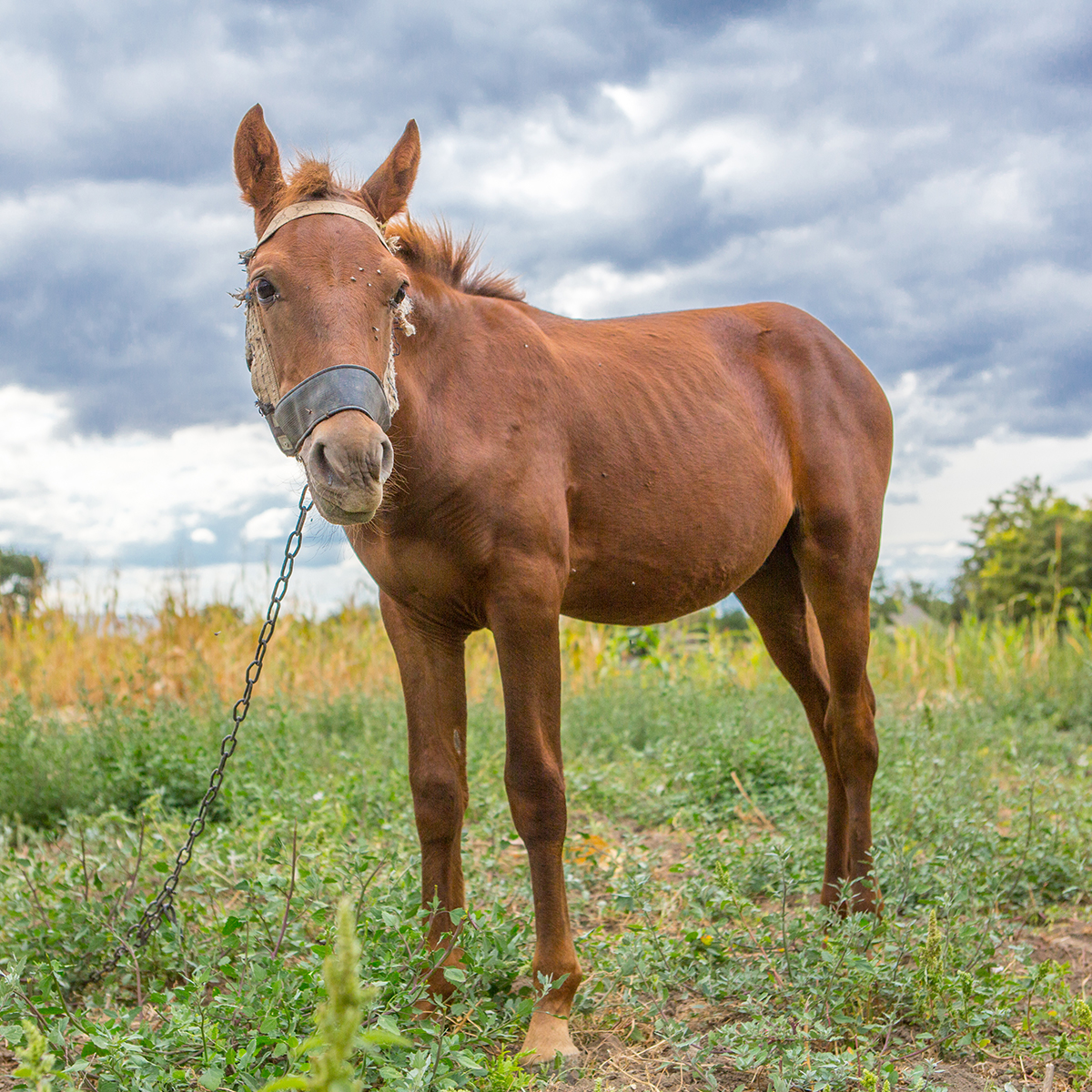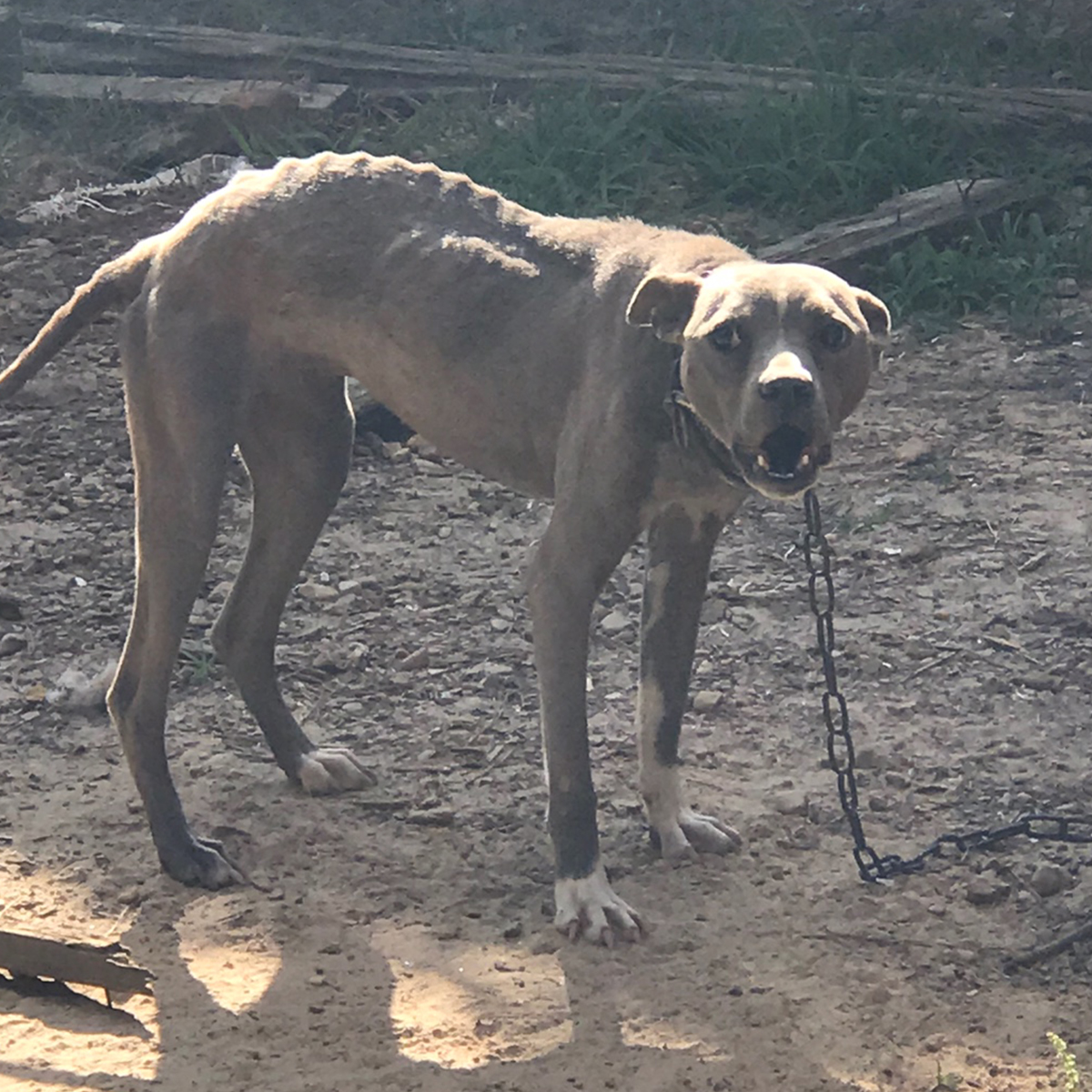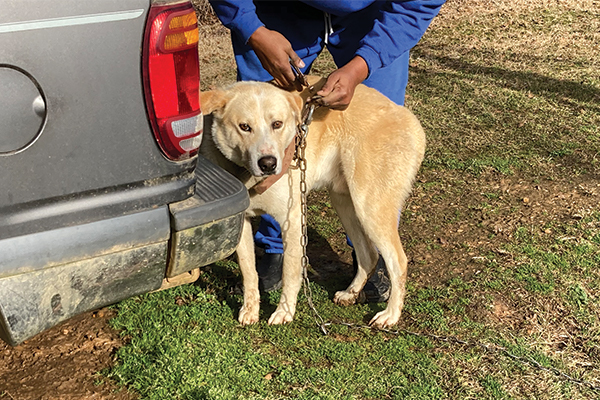Life On A Chain Is No Life At All
Across the world, millions of dogs (and other animals) endure almost their entire lives restricted outdoors by chains or ropes affixed to collars and staked to the ground or to fixed objects. Have all your questions about the practice answered and find out why it is harmful, and how you can help end it.
- What is tethering or chaining a dog?
- What does In Defense of Animals do to help chained animals?
- What can I do to help chained/tethered dogs?
What is tethering or chaining a dog?
In general, the terms “chaining” or “tethering” describe the practice of fastening a dog or other animal to a ground stake or a stationary object such as a tree, fence, car, or dog house for extended periods of time using a rope or chain. While this practice affects other animals, one of the most common types of victims is dogs. In some cases, chained dogs may be tethered for days, months, or even years. This practice poses serious threats to a dog’s physical and psychological well-being, and to the communities they live in. Due to the inhumane nature of continuous dog chaining, many areas are working to stop it.
Is tethering or chaining dogs legal?
As of 2021, 23 states and the District of Columbia have laws that ban or restrict tethering and chaining, as do dozens of cities and counties across the country. Restrictions may include the type of collars and tethers used, or the length of time dogs may be tethered, or they may be based on the weather, among other criteria. In some cases, dogs may also be protected from this practice by anti-cruelty laws.
Why do people tether or chain their dogs?
There are plenty of reasons why people tether or chain their dogs. Here we mention some common reasons.
- Many people chain or tether their dogs because that is how their family has always done it, and they are not educated about the harm it can cause their dogs or they do not know there are other options.
- Some people don’t have a fenced yard or it is in need of repair, and they can’t otherwise safely confine their dog.
- Their dog's behavior or actions make keeping them indoors challenging and people don't know how to correct their dog’s behavior.
The dog keeps running away and their guardian is trying to protect them and/or prevent another citation and dog-at-large fine.
Why is tethering and chaining extremely bad for dogs?
Dogs are truly social animal companions who need to engage with fellow canines, humans, and other animals for their mental health and get regular exercise for their physical well-being. Dogs who are isolated from social interactions for long periods of time become bored, lonely, and frustrated, and can develop serious health and behavioral issues, including aggression.
Many outdoor dogs are not fed properly, are not given clean water, and are not regularly examined. Even when food and water are provided, both can quickly become contaminated or knocked over, or out of reach.
Tethered or chained dogs may also be left in all types of weather without adequate shelter, and are extremely vulnerable to flea and tick infestations, flystrike, and other preventable diseases, and are left unable to escape attacks from other animals, and being harassed or harmed by humans.
Tragically, they’re also at risk of being seriously injured or killed. Sometimes, as young dogs grow older, their collar becomes too small and can become embedded in their necks, which is extremely painful and requires immediate veterinary attention.. They may also become seriously injured if they become entangled, and can easily die from strangulation.
Using pulley runs may offer dogs a little more room to move around, but they still come with many of the same risks and dangers.
Is it safe to tether a horse or other animals?
Even though horses and other farmed animals may be tethered to safely confine them, or give them opportunities to graze, this should only ever be done for short periods and they must be supervised or consistently checked. They’re vulnerable to many of the same hazards dogs are when left tethered, and if confined this way must be in a safe area free from obstructions, provided with food, water, and shelter, and regular opportunities to socialize and engage in natural behaviors.
How dangerous is it to chain and tether a dog?
Tethering or chaining isn’t just bad for dogs, it poses a serious public safety threat by creating a higher risk for bites. Dogs who are left tied up may become territorial, and become frustrated with their continued confinement and lack of opportunities to socialize. They’re also left unable to flee from situations or defend themselves from potential threats, which can cause them to become reactive and behave aggressively. Children who unwittingly approach dogs are often the victims of bites.
How should dogs be confined and restrained safely?
As human guardians, we must take care of and love our dogs responsibly and keep them in healthy and safe environments. Dogs should live indoors and be treated as members of our family. They need veterinary care and need to be able to exercise and socialize, and eat healthy food and drink clean water when they want. They should be kept in a well-fenced area with enough space to prevent them from escaping. Dogs who are kept outside most of the time should have a safe enclosure with proper shelter and access to food and water.
If dogs are going to be tethered, it should only be for short periods with supervision.
What does In Defense of Animals do to help tethered animals?
We advocate for dogs to be kept indoors as members of their households. We’re raising awareness about this issue through our Break the Chains campaign, working with lawmakers to pass anti-tethering laws, and aiding numerous animals in the Deep South by providing resources to guardians and aiding law enforcement with seizures of tethered animals in need of help.
What can I do to help chained/tethered dogs?
If you see an animal who appears to be permanently tethered, you can help change their lives forever. If you’re concerned about an animal, here are some steps you can take:
- Evaluate and document the situation, and take notes about the location, time, date, weather, whether there is shelter, food and water, and the condition the animal is in.
- Find out whether your state has an anti-tethering law, and look up your local ordinances.
- If tethering a dog is not against the law, you should consider politely talking to their guardian to help educate them about the harm tethering causes, and see if they’ll let you help the dog. You can also call your local animal control agency, which may be able to help improve the situation.
- If it is prohibited by law, call animal control or your local police, insist they intervene, and stay until someone arrives.
In any case, it’s important to avoid aggravating the problem and putting yourself and the dog at risk. If you can assess the situation, identify the problem realistically, and find the right approach, you can help dogs in the most appropriate way. If possible, it is best to let the people understand the problem and encourage them to stop tethering the dog. Some people do not understand the views and actions of animal advocates and animal rights organizations, but it is important to think about how to give them the right information to find the right solution to help animals.





